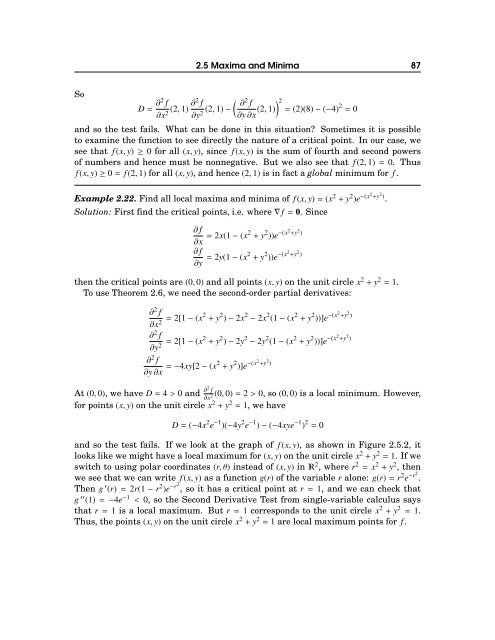Michael Corral: Vector Calculus
Michael Corral: Vector Calculus
Michael Corral: Vector Calculus
You also want an ePaper? Increase the reach of your titles
YUMPU automatically turns print PDFs into web optimized ePapers that Google loves.
2.5 Maxima and Minima 87<br />
So<br />
D= ∂2 f<br />
∂x 2(2,1)∂2 f<br />
∂y 2(2,1)− ( ∂ 2 f<br />
∂y∂x (2,1) ) 2=<br />
(2)(8)−(−4) 2 = 0<br />
and so the test fails. What can be done in this situation? Sometimes it is possible<br />
to examine the function to see directly the nature of a critical point. In our case, we<br />
see that f(x,y)≥0 for all (x,y), since f(x,y) is the sum of fourth and second powers<br />
of numbers and hence must be nonnegative. But we also see that f(2,1)=0. Thus<br />
f(x,y)≥0= f(2,1) for all (x,y), and hence (2,1) is in fact a global minimum for f.<br />
Example 2.22. Find all local maxima and minima of f(x,y)=(x 2 +y 2 )e −(x2 +y 2) .<br />
Solution: First find the critical points, i.e. where∇f= 0. Since<br />
∂f<br />
∂x = 2x(1−(x2 +y 2 ))e −(x2 +y 2 )<br />
∂f<br />
∂y = 2y(1−(x2 +y 2 ))e −(x2 +y 2 )<br />
then the critical points are (0,0) and all points (x,y) on the unit circle x 2 +y 2 = 1.<br />
To use Theorem 2.6, we need the second-order partial derivatives:<br />
∂ 2 f<br />
∂x 2= 2[1−(x2 +y 2 )−2x 2 −2x 2 (1−(x 2 +y 2 ))]e −(x2 +y 2 )<br />
∂ 2 f<br />
∂y 2= 2[1−(x2 +y 2 )−2y 2 −2y 2 (1−(x 2 +y 2 ))]e −(x2 +y 2 )<br />
∂ 2 f<br />
∂y∂x =−4xy[2−(x2 +y 2 )]e −(x2 +y 2 )<br />
At (0,0), we have D=4>0and ∂2 f<br />
∂x 2 (0,0)=2>0, so (0,0) is a local minimum. However,<br />
for points (x,y) on the unit circle x 2 +y 2 = 1, we have<br />
D=(−4x 2 e −1 )(−4y 2 e −1 )−(−4xye −1 ) 2 = 0<br />
and so the test fails. If we look at the graph of f(x,y), as shown in Figure 2.5.2, it<br />
looks like we might have a local maximum for (x,y) on the unit circle x 2 +y 2 = 1. If we<br />
switch to using polar coordinates (r,θ) instead of (x,y) in 2 , where r 2 = x 2 + y 2 , then<br />
we see that we can write f(x,y) as a function g(r) of the variable r alone: g(r)=r 2 e −r2 .<br />
Then g ′ (r)=2r(1−r 2 )e −r2 , so it has a critical point at r=1, and we can check that<br />
g ′′ (1)=−4e −1 < 0, so the Second Derivative Test from single-variable calculus says<br />
that r=1 is a local maximum. But r=1 corresponds to the unit circle x 2 + y 2 = 1.<br />
Thus, the points (x,y) on the unit circle x 2 +y 2 = 1 are local maximum points for f.








